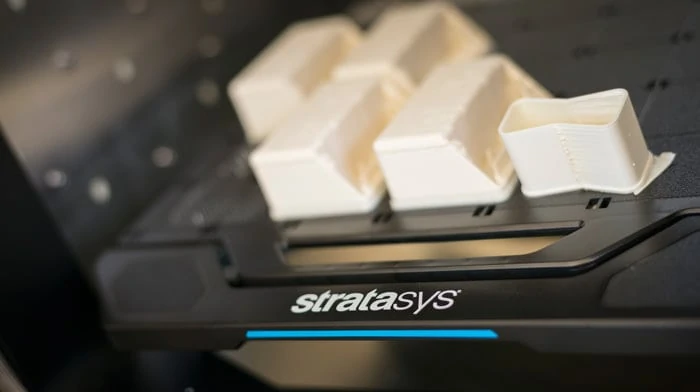
Stratasys
Stratasys is the world’s largest manufacturer of 3D printers and associated products. It is one of Laser Lines’ major suppliers and we are one of its Platinum Partners.
This article is a summary of the Stratasys story, from inception through to future prospects, with the aim being to answer any and all questions you may have about the global leader in 3D printing.
Stratasys 3D Printers
How Stratasys Began
The first steps towards the founding of Stratasys began in 1989 when inventor Scott Crump, intent on making a unique toy for his daughter, started experimenting with methods he might use to do so. He decided to try to build a model, one layer at a time, using a mixture of plastic and wax; the plastic providing enough rigidity to make the end result viable, whilst the wax gave the mixture a low melting point which allowed Scott to easily extrude it using only the equipment in his garage.
He went on to build a prototype and gain a patent for his process, which he named Fused Deposition Modelling. Stratasys was the name he chose for the company set up to market the process and in 1992 the first commercially viable machine was sold under the moniker ‘3D Modeler’.
The Growth of Stratasys and the 3D Printing Industry
Since its incorporation, Stratasys has experienced phenomenal growth and has moved in various directions. Many of these developments warrant discussion in their own right; the following is just a snapshot of what the company were doing in each year until the modern day.
Stratasys’ Timeline
1989 – The company was founded. It was registered in Delaware whilst the headquarters were, and still are, found at 7665 Commerce Way Eden Prairie, Minnesota 55344.
1990 – Stratasys began filing some of the patents it went on to use in successful iterations of 3D printing technology. Important examples this year being US Patent 4863538, described as a ‘Method and apparatus for producing parts by selective sintering’ which lays out the basic process of laser sintering, still recognisable in today’s SLS machines. Also US Patent 4837732. A ‘Method and apparatus for the three-dimensional registration and display of prepared teeth’. This was one of the earliest patents involving dentistry and 3D printing technology. Dental work has since blossomed into one of the most profitable niches in the 3D printing sector, due to the uniqueness of teeth and the value inherent in their protection and repair.
1991 – Further patents were published. US 4938816, US 4976813 and US 4922852 made improvements on SLS powder handling, the composition of solder masks for thermoplastic substrates and the regulation of thermoplastic extrusion via nozzle pressure sensors, respectively.
1992 – Marshall Burns produced a report for the respected Management Roundtable group, entitled Rapid Prototyping: System Selection and Implementation Guide. In it, he noted that Stratasys are the company closest to producing a desktop rapid prototyping machine “with their Fused Deposition Modelling process” and their first commercial product, the ‘3D Modeller’.
1993 – A symposium, organised by the Center for Materials Science and Engineering at the University of Texas, received input from Stratasys employees Jim Comb (Principal Systems Engineer) and Bill Priedeman (Senior Research Scientist). Their contribution was a paper entitled Control Parameters and Material Selection Criteria for Rapid Prototyping Systems in which they note that the first Stratasys machines went out for real world testing two years prior to the date of the symposium. They state that this has given them substantial feedback and data to work with and that a major push around control parameters and related software has been one of the results. They talk about using software to control, amongst other things, “oozing” from the nozzle after the machine shuts down, and warping in the foundations of thicker builds.
1995 – Stratasys purchased IBM’s rapid prototyping, an intellectual property, as well as other assets. Stratasys went onto to employ 16 former IBM engineers, who had been working on the development of a small 3D printer, that was very similar to the extrusion system that the Stratasys founder’s FDM technology. Rapid Prototyping could be defined/explained through a group of techniques, used to fabricate a scale model of an assembly or physical part, as a result of using 3D computer aided design data (CAD data).
2003 – Stratasys’ Fused Deposition Modelling (FDM) was the best-selling rapid prototyping technology. A technology patented by Stratasys, essentially allows production of three-dimensional parts, directly from CAD (Computer Aided Design) and does so layer-by-layer. This technology is best utilised in design verification, prototyping, development and manufacturing.
2012 – An unrelated project to produce a working firearm via 3D printing, was intended to use a Stratasys 3D printer. Stratasys morally refused to allow this, and thus withdrew its licence for use of the 3D printers. It was cited that Stratasys did not allow its printers ‘to be used for illegal purposes’.
Acquisitions, Offshoots and Evolutions
Stratasys’ Acquisition of Objet
In 2012, on the back of a number of years of appreciating market capitalisation, Stratasys took an important step by approaching Israel-based rival Objet Geometries about a potential merger. Objet was a large company in its own right, with an estimated value at the time of around $1.4 billion, and it was in the process of making an initial public offering on the stock market, with a view to raising $75 million for research and development.
Objet and Stratasys already had some operational history as Stratasys had previously been the Objet distributor in North America. This may have helped smooth out any wrinkles in the negotiation process as the companies came to a mutually favourable agreement whereby Stratasys would buy Objet, and Objet senior management would then fill a number of top roles in the new company. This included the CEO position which was taken by David Reis, Objet’s CEO, whilst Scott Crump moved sideways into an Executive Chairman role.
Stratasys did not spell out exactly why it had wanted the merger to take place, and it wasn’t entirely obvious to industry commentators, who noted that the products offered by the companies were broadly similar, albeit Objet’s printers were slightly more lightweight and had been used predominantly for manufacturing smaller goods, like parts for trainers, whereas Stratasys machines had been used for parts of a BMW production line, amongst other uses. A press release was issued, which mentioned a broader reach being achieved by the combined companies versus the separate entities. In all likelihood, it was probably due to a need to combine budgets and keep on top of research investment to ensure ongoing competitiveness with 3D Systems.
Stratasys’ Acquisition of Makerbot
For many years, Stratasys’ only significant focus was on building machines designed to serve the manufacturing community. Its printers were almost exclusively used in factories to facilitate rapid prototyping and the reduction in price associated with the easy creation of custom jigs and fixtures in otherwise standard processes. Stratasys’ tooling capabilities were well known to manufacturers and the company had achieved considerable success in this sector.
However, during the early 2000s there was a movement within the industry towards the domestic consumer; potentially another multi-billion-dollar market. Stratasys reacted to this in 2013 by purchasing Makerbot, a mid-sized 3D printer manufacturer which had been solely concentrating on this emerging market and who had built up a considerable following by open-sourcing all of its hardware up until 2012.
The two companies continued to operate independently of each other but shared resources. This allowed Makerbot access to the design and engineering resources, and the capital it needed to grow whilst providing Stratasys with a substantial piece of the consumer market and associated developmental and marketing synergies. A press release put together by Stratasys at the time of the acquisition states it thought that combined coverage of the two companies would help to push a “faster adoption of 3D printing” across the board.
3dprinting.co.uk Official Platinum Partners
Becoming a platinum partner of Stratasys requires a certain level of both service, and professionalism. It is more than just selling Stratasys 3D printers. 3dprinting.co.uk acts as partner and advisor to Stratasys, providing solutions and industry expertise. As Stratasys platinum partners we are fully committed to building long-term, strategic relationships with our customers, as well as making sure we maintain our industry knowledge by staying up-to-date with the advances and progressions of the 3D printing and additive manufacturing industry. It is a combination of these factors that led to 3dprinting.co.uk being named a platinum partner of Stratasys in 2017.








